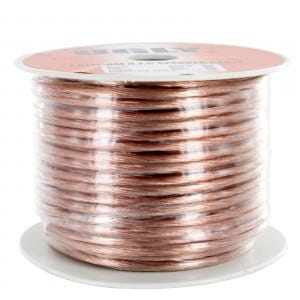American Wire Gauge (AWG) is the standard grading used on speaker wire. Used since 1857, it indicates the diameter of round, solid or stranded electrically conducting wire. The diameter of each gauge is a factor in determining its’ current capacity. When the gauge number increases, the wire diameter decreases.
Stranded wire which is commonly used in audio visual applications has an AWG which is determined by the total cross-sectional area of the conductor, which determines its current capacity and electrical resistance. Because there are small gaps between the strands, stranded wire will always have a slightly larger overall diameter than a solid wire with the same AWG.
A poorly chosen AWG can compromise the sound quality of your speakers. Since thicker wire carries more current because it has less electrical resistance over a given length, thicker wire is better for longer distances. This is why it is important not to take short-cuts when selecting the right speaker cable for your AV set up.
You need to match the AWG to the sound system. You also need to consider that the longer the run, the more likely you will hear significant power losses and so need to go a bit thicker. You need to look at what style terminals your speakers and receiver has and you need to decide if you are going to use specialty speaker connectors such as banana plugs.
These are our recommended minimum cable AWG required for optimal performance at a given length determined by speaker impedence.
|
4 ohm |
6 ohm |
8 ohm |
||||
|
16 AWG |
7m |
11m |
15m |
|||
|
12 AWG |
18m |
27m |
37m |
|||
|
10 AWG |
30m |
46m |
61m |
For example, a 16AWG suits up to 15m with 8 ohm speakers.
It is important to note that for runs longer than 18m, some high frequency loss may occur. Performance can be improved by going up a size (down in gauge number).
If you would like some advice about which gauge wire will suit your set up, why not call and talk to one of our Selby Techs on 1800 69 2225








